Texas Rig Plastic Fishing Lures When Fishing Heavy Cover
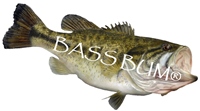
In its most basic form a Texas rig consists of a sliding sinker, preferably bullet shaped, and a straight shank hook upon which a worm is threaded with the hook point buried in the body of the worm to make it "weedless". The worm must be straight on the hook, otherwise, the angler gets terrible line twist, absent a swivel, and the lure's action will appear unnatural.
Classic Texas Rig - Berkley 7" Power Worm - Motor Oil/Red Fleck

This rig has a significant advantage over most other rigs in that it can be fished across almost any bottom type and worked relatively snag free through stumps, rocks and brush. It's safe to say that most anglers consider this the "Go To" rig when fishing heavy cover.
Creating the Texas Rig
The basic Texas rigged worm (the granddaddy of Texas rigged lures) is made by simply
- Threading your line through your sinker.
- Then tie on your hook. Be sure the bullet end of your sinker is facing your rod tip.
- You then insert the point of your hook into the head of the worm threading it on the hook.
- Then push the hook tip out the side of the worm, about 1/4 to 1/2 inch down the length of the body.
- Continue threading the worm
on the hook until only the eye remains protruding from the head.
- Then twist the hook a half-turn so the hook tip is pointing at the worms side.
- Finally, push the hook into the worm but not through it or completely through the worm if you're going to "skin-hook" it. Lastly, pull the head of the worm over the hook eye.
Joining the Worm and Hook
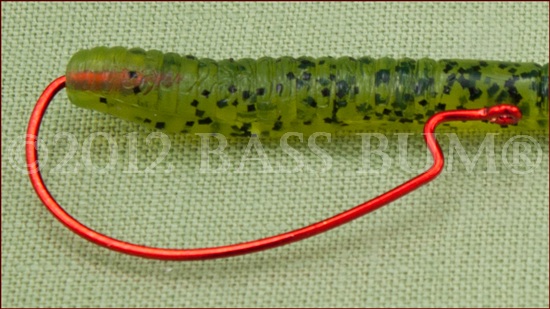
Insert the hook point into the head of the worm pushing in up to the bend before directing the point out the worm's side.
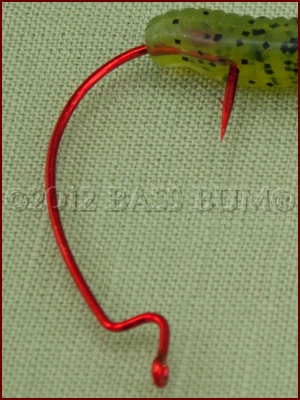
Push the hook point out the side of the worm 1/4 to 1/2 inch down its length.

With just the hook eye still protruding from the worm's head, twist the hook a half turn until its point is toward the worm body.
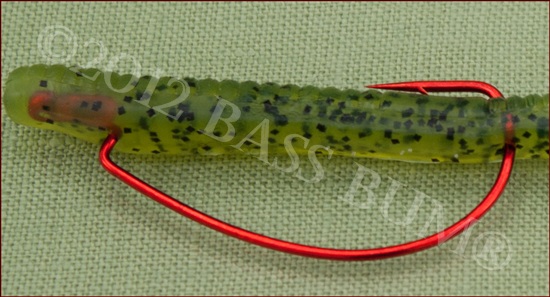
After pushing the hook point into and through the worm make sure the hook is centered and that the lure hangs "straight". Otherwise you will get line twist. Be sure and pull the worm over the hook's eye after tying on to your line.
This picture shows the hook point exposed. Skin hooking as discussed below is better to protect against hang ups.

Hook Selection for Texas Rigging
Though there is no hard and fast rule for hook selection, hook size is correctly determined by the "length" of the soft plastic lure being fished. But what about the thickness, weight and buoyancy of the lure? Do these factor in? What about line weight and type? When should the hook be heavy or light wire in a Texas Rig?
Which hook style is better for a Texas Rig, straight shank, offset shank or EWG? Many, me included, feel that you can get better hook sets with a straight shank hook when fishing plastic worms. However, if the lure is bulky like a tube, some craws or any of a myriad of creature baits which tend to be thicker, wider and heavier than a worm. Then a wide gap hook with and offset shank is better. Another good choice could also be a round bend offset straight shank hook depending on the shape of the lure.
As you spend time on the water you'll determine which is best for your personal fishing style, techniques and favorite lures.
When fishing heavy cover with a Texas Rig it's best that you "skin-hook" the hook's tip, that is, push the point completely through the lure then bury it just under the surface of the lure's skin. This will greatly contribute to making it "snag-less" whereas leaving the hook point exposed as shown below right will lead to frustrating "hang-ups".

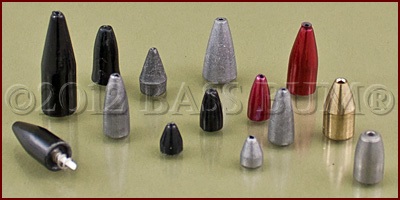
Sinker Selection
One of the most common mistakes anglers make is using to much weight with the Texas Rig. The sinker should be as light as possible while still getting the lure down and and once down enables you to "feel" the cover and structure you're fishing. The lighter the weight the more natural the lures action.
Shallow water 6´ or less calls for a sinker of 1/6 to 1/8 ounce. If in water 6´ to 12´ in depth then a 1/8 to 1/4 ounce is better. Sinkers 1/4 to 3/8 ounce are good for water between 13´ and 18´ deep and anything over that calls for a 3/8 to a full once sinker.
Which is better,a sliding or fixed sinker?
When a sinker slides up and down the line, as it moves over a log or limb, it can sometimes cause the lure to "hang up" on the cover as it follows the sinker over. When lure and sinker are separate, the sinker can get wrapped around a limb, twig or branch.
Consequently, some anglers use sinkers that have "screws" which enable them to screw the sinker into the head of the lure (as shown at above left) or they just use the old method of forcing a toothpick into the sinker's hole next to the line and breaking it off. When the toothpick goes into the water the wood swells and makes the fit snug "fixing" the sinker on the line next to the head of the lure.
Personally, my experience with this was to have the line so weakened at that point that it breaks. I'm convinced this has cost me fish so I avoid "pegging" with a toothpick or even fixing the sinker at all unless fishing very "gnarly" cover. In the latter case I'll use a "bobber stop" situated above the sinker but pushed down to the sinker's nose to fix the sinker in place. No line damage results from this and the head of the lure is not mangled as can happen with a screw type sinker.
Line Selection
Line should be at least 12-14lbs and abrasion resistant monofilament. Trilene XT, which is very abrasion resistant, is good for Texas Rigs. It is larger in diameter than many other lines and can cause manageability problems on a spinning reel however. To enhance the ability of my old eyes to see line movement after a light pick up I sometimes use Stren fluorescent line, though it too is of a larger diameter.
A line I've adopted as my primary line after two years of unbelievable success with it is Trilene "Sensation". It's a small diameter line so strong that it's almost impossible for me to break when I get hung up. It has good knot strength and is very manageable with spinning gear. I use it in many of my presentations for both live and artificial bait.
Some choose to use superlines as heavy as 17-30lbs when flipping or pitching a Texas Rig as they are not concerned about the visibility of these lines in heavy cover. Additionally, the superlines won't result in as many break-offs as with mono in heavy cover. Some are quite visible in clear, open water however.
Rod and Reel
Your rod should be one with significant backbone so you can generate a powerful hook set. You have to be able to drive the hook not only through the plastic lure, which may be bunched up into a glob by the bass' strike, but also through the very tough jaw of the bass.
A good graphite rod 7´ to 7 1/2´ in length that is medium heavy, fast action should suffice for most Texas Rig applications.
If you're pitching or flipping into very heavy cover then you might want to use a heavy "flippin stick". For example, I use an All Star TAS 908BB "flippin stick" that is 7´ 6" long with heavy power and fast action for this. I combine it with a Shimano Castaic CA-201SF casting reel.
Return to Fishing Rigs from Texas Rig
